What defines a meme in 2018?
Richard Dawkins’ concept of a meme does not align with contemporary internet culture.
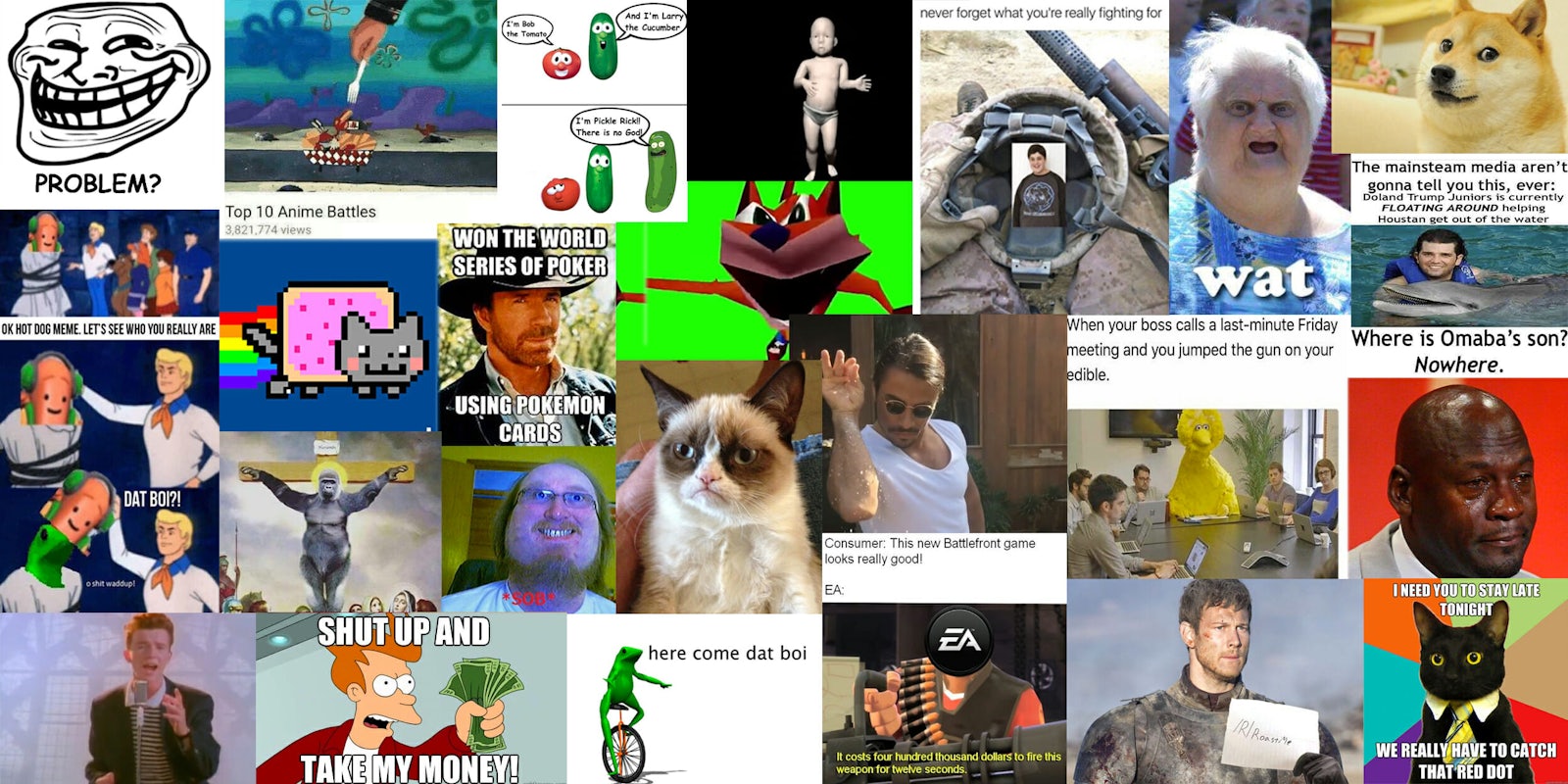
What defines a meme? Many explanations start by mentioning that the word “meme” was first introduced by renowned biologist and outspoken Twitter personality Richard Dawkins in his 1976 publication.Genes Act in Their Own InterestFeel free to toss those explanations aside—today’s meaning of “meme” is far removed from Dawkins’ initial concept, and no biology degree is required to grasp it.
Dawkins described a meme as a viral concept, a notion that spreads effortlessly and outlasts rival ideas. An internet meme, on the other hand, is distinctly different. It’s more than just a thought—it takes shape. Whether an image, clip, animated figure, or trending phrase on Twitter, the format is irrelevant so long as people engage with it and personalize it. When it’s shared, adapted, and reshared across platforms until it becomes part of the cultural fabric, it achieves meme status.
A meme carries the vibe of an “inside joke,” but it’s spread among thousands or even millions, not limited to a tight-knit group. Even with such massive exposure, memes retain the thrill of shared understanding and that sense of “getting it.” In 2017, kids toss meme references back and forth as effortlessly as ’90s kids did withThe Simpsons is an animated television series created by Matt Groening. The show follows the lives of the Simpson family—Homer, Marge, Bart, Lisa, and Maggie—as they navigate the quirks of everyday life in the fictional town of Springfield. Known for its satirical humor and cultural commentary, the series has become a long-standing staple of American pop culture since its debut in 1989. With its distinctive animation style and memorable characters, The Simpsons has garnered a massive global fanbase and remains one of the most influential TV shows in history.Unless you barely spend any time on Twitter, Tumblr, or Reddit, making sense of memes might seem like decipheringSimpsonsReferencing the show without ever seeing it is common, but once you understand, these moments become a vibrant, shared experience with nearly endless possibilities.
A meme might take the form of a fictional character, such as the melancholy frog Pepe or the cheerful figure called “Dat Boi.” It could also depict a real individual, like Ken Bone, the red-sweatered standout from the 2016 presidential debates. Alternatively, it might reference a deceased animal, such as the gorilla Harambe (R.I.P.). A meme can even be a popular phrase, like “first of all …” or “eyebrows on fleek,” or a song, such as “Shooting Stars” or “We Are Number One.” Most abstractly, it can function as a game—an image or word structure that inspires meme makers to insert their own comedic twists.
Memes are often humorous, yet they aren’t merely simple jokes.justMemes are more than just jokes. They form the foundation of a modern, democratic medium rooted in grassroots movements, a space where corporations continue to face challenges in exerting control and monetizing influence. Unlike top-down directives, memes emerge organically through widespread sharing—reblogged and retweeted by countless users.
What defines a meme, and what is its origin?
Memes represent one of the most accessible forms of media in terms of participation. The requirements to get started are minimal. While skills like using Photoshop or creating videos can be beneficial, even someone with just a Twitter account and ambition can create a viral meme. At the same time, the rivalry is intense. Contrary to Dawkins’ idea of a meme, which spreads almost like an infection, internet memes are shared deliberately. Though creating, viewing, or retweeting memes doesn’t require financial investment, people actively circulate jokes that boost their social standing and earn approval. In other words, they primarily spread humor that resonates.
For a joke to evolve into a widely recognized meme, it requires the right platform. Certain online communities have established themselves as the most consistent breeding grounds for emerging memes. While this isn’t an exhaustive rundown, any genuine conversation about meme origins must include these spaces:
In 2017, “Black Twitter,” the widely recognized term for the cultural dialogue and interaction among African-Americans on the platform, stands out as the most vibrant generator of memes. (Given Twitter’s broad reach and the fact that Black Twitter produces a significant portion of the platform’s original, humorous, and engaging content, it might as well be referred to simply as “Twitter.”)
Black culture, shared through Twitter, has produced many of the most iconic memes in recent memory. Take, for instance, meme sensations Roll Safe and Big Shaq. These characters were initially crafted by U.K. comedians but gained widespread fame in the U.S. due to the influence of Black Twitter. Well-known humor formats such as “First of all …” and recurring themes like Crying Michael Jordan or Arthur the aardvark’s clenched fist also trace their origins to Black Twitter.
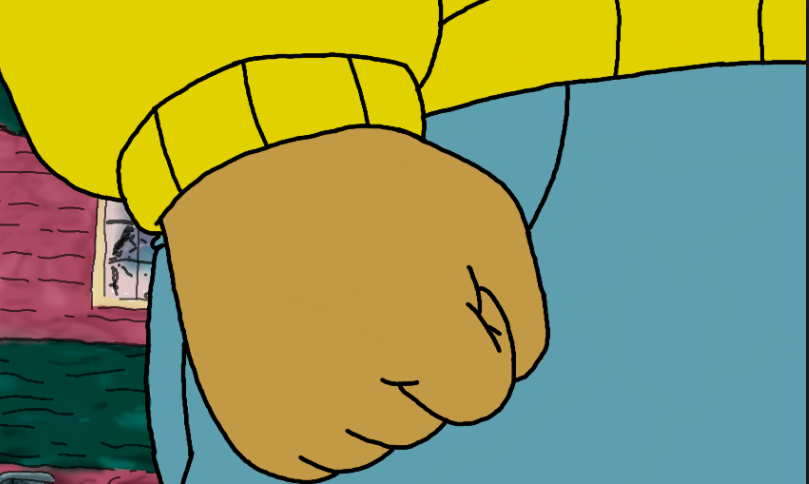
Beyond the array of viral reaction GIFs featuring black celebrities, there’s another layer to consider. These images are frequently appropriated by white users, leading critics to label the phenomenon as “digital blackface.”
News platforms focused on Black culture, such as Bossip and , play a significant role in quickly disseminating Black Twitter humor across various social media platforms. Similarly, numerous Twitter accounts that compile jokes without attribution contribute to this trend. For instance, a Twitter account named is exclusively devoted to sharing the most viral tweets.
If something is hilarious or impressive, it likely originated on Black Twitter.
Notable subcultures on Twitter include “,” a collective of absurdist humor accounts originating from the enduring Something Awful forums. The movement is often linked to the handle “,” famous for its legendary posts that have sparked countless imitations. Another significant group is “Left Twitter,” which has grown around the Democratic Socialists of America and the progressive podcast., overlaps with Weird Twitter yet generates distinctive and impactful memes independently.
4chan
4chan is an unruly online forum where users post anonymously, often sharing extremely offensive content, yet it also serves as a vital breeding ground for memes. Before the rise of modern “social media,” 4chan’s infamous /b/ board spawned cultural phenomena such as LOLcats, Rickrolling, and Pedobear. These were initially seen as niche humor, but today they are recognized as foundational memes.
A 2016 analysis of posts on the meme database Know Your Meme revealed that 4chan generated 12 percent of all memes. While the exact figures may be disputed, 4chan’s impact remains unquestionable.
Since 2016, /pol/ has overtaken /b/ as the most discussed board on 4chan, known as the “politically incorrect”—or more accurately, “white supremacist”—hub that backed Donald Trump’s presidential bid. It serves as a breeding ground for racist ideologies, and the memes it generated during the election cycle were far from harmless, unlike the lighthearted cat memes of the past. Together with Reddit’s infamous Trump community, r/the_donald—often referred to as “a satellite of /pol/”—they repurposed the ordinary cartoon figure Pepe the Frog into a symbol associated with Nazism. The meme creators on /pol/ later embraced the Egyptian frog deity Kek, engaging in “The Great Meme War of 2016” against supporters of Bernie Sanders from the left. (For a detailed exploration of The Great Meme War, refer to this comprehensive Politico article.)
Because of /pol/, 4chan remains influential, with its memes receiving as much attention from mainstream media as before. However, the site’s original chaotic hacker spirit has faded, giving way to white nationalism and an obsession with Trump.
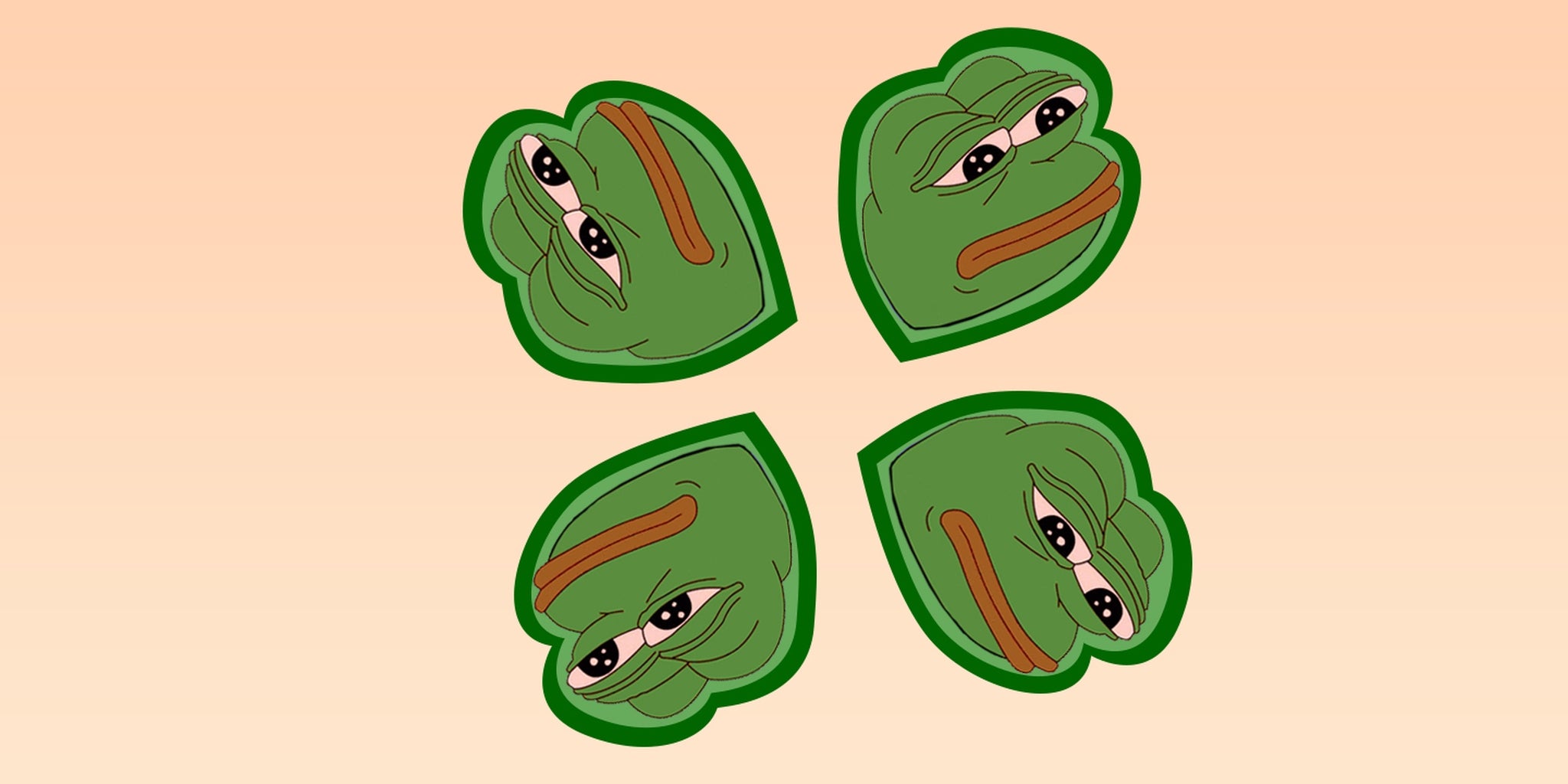
Reddit was originally perceived by meme enthusiasts as a mainstream platform that gained traction by recycling content from 4chan. In its early days, it focused heavily on outdated meme formats such as Advice Animals and Rage Comics, but over ten years later, it has evolved into something far greater. To discover original content on the “front page of the internet,” users must venture past its most generic and uninspired forums (like r/funny) and explore the true hubs of meme culture. Two prominent subreddits exemplify this shift: r/dankmemes and r/me_irl.
Dankmemes serves as the unruly, polarizing hub for “edgy” humor, frequently tackling dark themes such as suicide, school shootings, and incest. While these subjects rarely resonate on mainstream platforms like Facebook, creators in the dank memes community excel at identifying or inventing fresh meme formats that can be repurposed for any topic. With over 300,000 members as of December 2017, the subreddit is sizable enough that its most popular content often spreads across Reddit and eventually leaks into broader internet culture.
Me_irl functions as a broad meme subreddit, framed around the idea that users share memes to represent themselves—essentially, “me, in real life.” This often results in self-deprecating or somber posts, yet me_irl has also become a central hub for Reddit’s meme culture. Its influence is so significant that a slump in activity during 2016 was dubbed “The Great Meme Drought,” while its subsequent revival was celebrated as a “Meme Renaissance.” The subreddit has popularized many recurring meme themes on Reddit, including Bionicles and the yearly “skeleton war.” Additionally, it maintains the weekly tradition of the It Is Wednesday, My Dudes frog meme.
Another subreddit worth monitoring is r/memeeconomy, even though it doesn’t create its own content. This platform tracks trending memes and identifies those fading in popularity. By browsing r/memeeconomy, you can quickly gauge the most popular memes across key meme-focused subreddits. Additionally, it hosts the sole monthly publication exclusively focused on memes.Meme Insider.
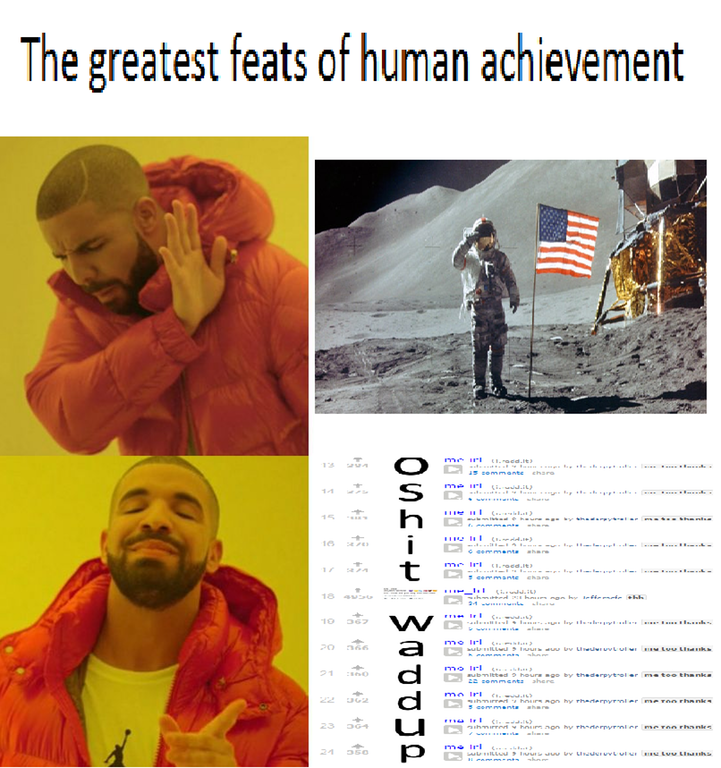
Tumblr
Tumblr stands apart in the world of memes. The platform skews younger and more progressive than most other meme hubs, while also having a strong focus on pop-culture fan communities.Doctor Whoanime, video games, young adult fiction,My Little PonyTumblr users often fixate on these topics, resulting in memes that feel niche and confusing to those unfamiliar with the platform.
Tumblr’s comment system, where users reblog posts to their own blogs to continue discussions, often creates a chat-like atmosphere. Unlike Twitter’s character restrictions or Reddit’s emphasis on quick, upvote-driven humor, Tumblr excels as a platform for text-based memes and phrases such as “I am forcibly removed from the premises” or “Do you take constructive criticism?”
The best content on Tumblr is wildly unpredictable, ranging from teenagers sharing historical memes to a creature from an ’80s milk carton ad to individuals inexplicably buried under heaps of grain. While not every Tumblr meme translates well to other platforms, the site has its own unique humor and style. Sadly, Tumblr doesn’t offer an effective search feature, making it necessary to follow numerous users or depend on external resources like the fantastic Meme Documentation to discover the best posts.
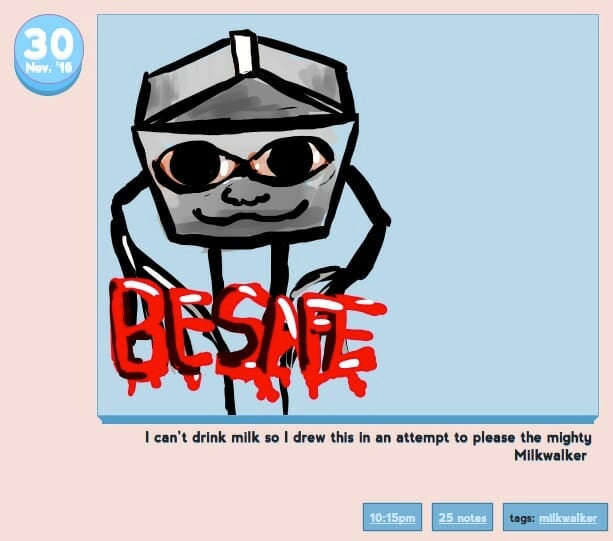
YouTube
In 2017, YouTube became a chaotic hub dominated by gamers, far-right figures, and even far-right gamers. Much like television, it serves as a breeding ground for memes by supplying the foundational content. Independent creators such as Ethan Klein (h3h3productions), iDubbbz, and Filthy Frank have all become popular meme subjects on Reddit. At the same time, top-tier YouTubers like Jake Paul and PewDiePie face ridicule and meme treatment similar to traditional Hollywood or music stars. The only difference is their platform—YouTube.
YouTube plays another key role in the meme ecosystem by serving as the primary platform for sharing video-based memes. While it may not generate significantly more original content compared to other sites, it faces little rivalry in the video domain. This explains why, as highlighted in the 2016 study on meme origins, YouTube contributed to more memes than any other platform—13 percent.
Popular meme YouTubers such as grandayy attract millions of views by reworking songs that hold significance in meme culture, like “We Are Number One” from the children’s series.LazyTown, Smash Mouth’s hit “All Star,” along with Darude’s iconic track “Sandstorm.”
YouTube serves as a platform for sharing memorable TV moments, particularly from series that have become popular sources for memes, such asSpongebob Squarepants and Jimmy Neutrontwist and warp beyond recognition, spawning viral sayings that spread across different platforms.
Original YouTube memes such as “” don’t simply recycle pre-existing intellectual property; they bring fresh characters and humor into the cultural conversation. These elements are then shared and remixed, evolving into even more variations.moreMemes create a self-perpetuating cycle—whether beneficial or harmful hinges on the toxicity of the content.
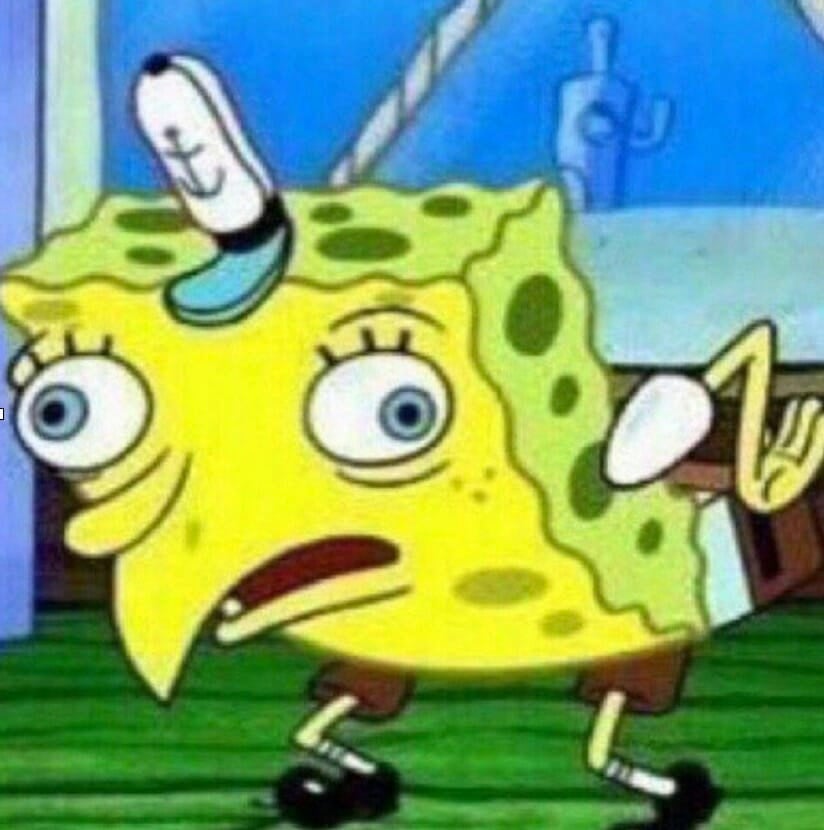
Meme pages on Facebook and Instagram
Facebook and Instagram host numerous popular meme pages with massive audiences. Accounts such as “The Fat Jew” often share recycled content from other sources. Once a meme appears on these high-profile pages, boasting hundreds of thousands or even millions of followers, it has reached mainstream status and is likely deemed “dead” by creators in communities that prioritize originality.
Exceptions exist—certain pages within Facebook and Instagram’s ecosystem generate their own content—though they are rare. The Facebook page that brought the Meme Man character to prominence—a basic 3D head model—serves as a key example. Another is Leftist Facebook, often referred to as “Leftbook.” You might also be familiar with Bernie Sanders’ Dank Meme Stash.
Facebook serves as a hub for group Messenger conversations and university-themed meme pages, where memes circulate and gain popularity away from the public spotlight. This mirrors the concept once referred to as “dark social” by internet enthusiasts, in which links would propagate via email and private chats, evading the tracking capabilities of analytics tools. Similar to how not every viewer ofThe Simpsons is an animated television series created by Matt Groening. It follows the lives of the Simpson family—Homer, Marge, Bart, Lisa, and Maggie—as well as the eccentric residents of their hometown, Springfield. Known for its humor, satire, and cultural commentary, the show has become a long-running and influential part of American pop culture.during the 1990s People might reference it in discussion, but not all those familiar with memes post them on public social media platforms.
Typically, however, Facebook isn’t the birthplace of memes. It’s where they eventually fade away.
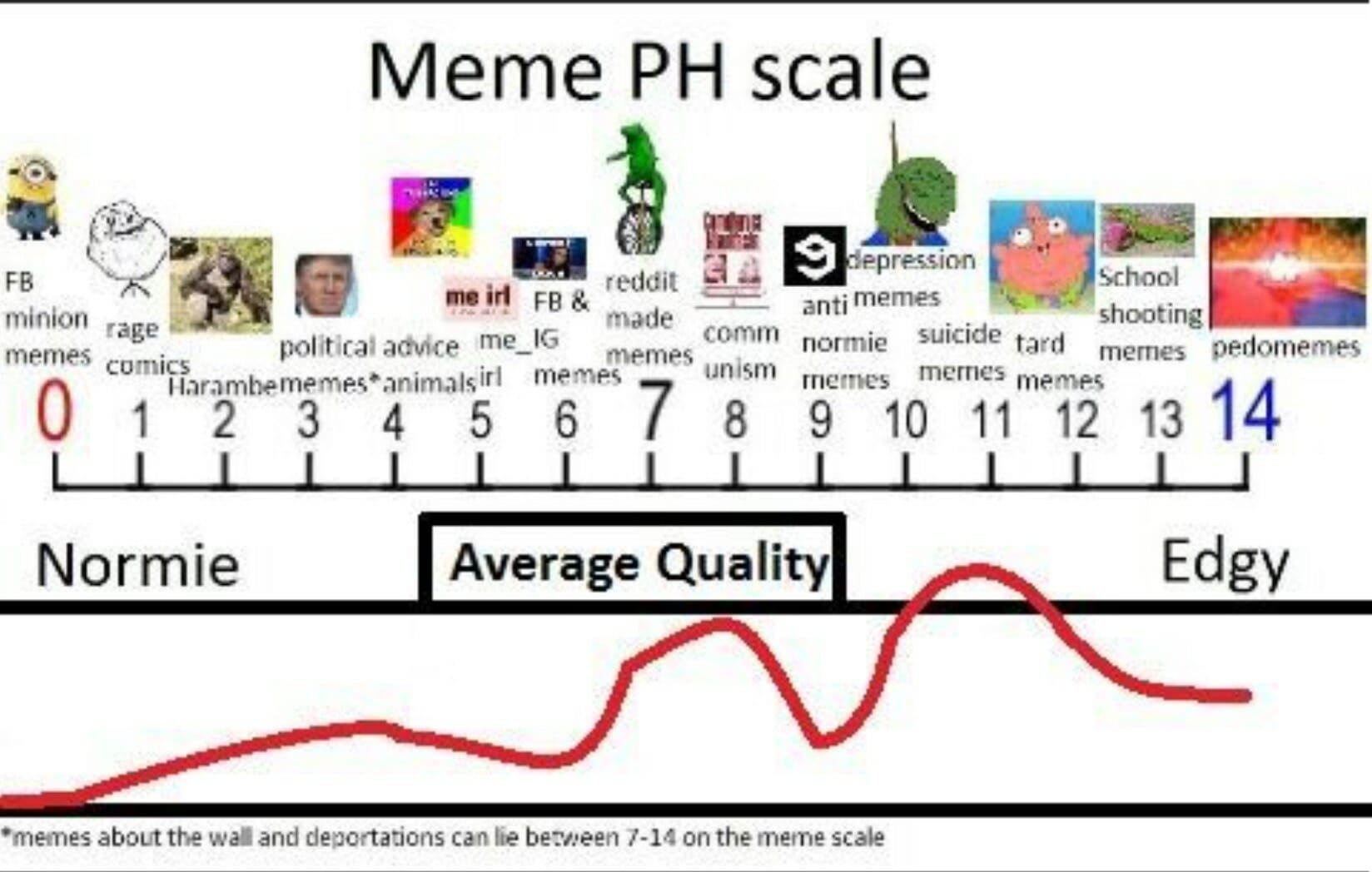
What drives the rise and fall of memes?
When a meme gains traction within one of the aforementioned communities, it begins to propagate and attract attention from secondary outlets. Platforms dedicated to meme culture, such as the highly detailed Know Your Meme and the divisive YouTube channel Behind the Meme, can legitimize a meme and introduce it to a broader audience. However, this exposure often accelerates the meme’s decline. As the highest-traffic site that actively engages with memes, BuzzFeed frequently faces criticism for draining the humor out of them.
When memes receive news coverage, they lose their subcultural appeal, becoming less trendy and prompting creators to abandon them for the next big thing. The Daily Dot’s reporting on memes plays just as much a role in this cycle as any other outlet. Admittedly, we contribute to the death of memes. And no, we aren’t bothered by it. That’s simply how the cycle works, and it affects everyone equally.
The typical path a meme follows from creation to obsolescence can be summarized… like this, more or less. While we’ve established that 4chan isn’t the sole origin of memes, this rough Human Centipede analogy remains largely correct:
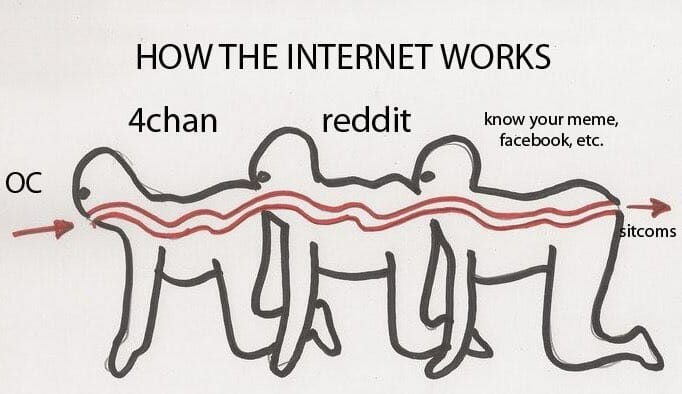
Once a meme appears on derivative platforms such as 9gag and iFunny.co—which Reddit views as unoriginal content thieves and objects of ridicule—its decline is inevitable.
The following stage involves media attention: the bigger the news organization, the quicker the meme fades. BuzzFeed, prominent news channels, andEllenFew things extinguish memes as quickly and decisively in the digital ecosystem. Just look at what happened to Damn, Daniel.
Once a meme enters the mainstream, it spreads rapidly across Facebook and Instagram, where only “normies” and parents still find it amusing. At that point, the meme’s final stage is commercialization. Its popularity reaches executives, and social media teams at big brands convince their higher-ups to approve its use on Twitter and Facebook. It could even get a shoutout on a hit TV series likeThe Big Bang Theory explains the origin and expansion of the universe from an extremely hot and dense initial state.
R.I.P., that meme. It’s similar to Ashton Kutcher: universally known but no longer trendy. (Unless it’sironicallycool, but the unusual second acts of memes tell a completely different tale.)
The Economy of Memes
The cultural worth of a meme—derived from its humor, wit, rebelliousness, or appeal—is gauged by what’s known as the “meme economy.” Functioning similarly to the stock market, albeit in a more absurd way, it sees users treating memes as tradable assets, monitoring their surges and declines. For the most part, it’s all in good fun: Online users relish role-playing as “investors,” predicting the next viral sensation or proclaiming a past trend obsolete. They take something as lighthearted as Pepe the Frog images and overlay the jargon of finance, pretending these hold genuine significance.
In the meme economy, “buying” refers to generating and distributing additional content of a meme or format. “Selling” involves releasing your complete inventory of that meme immediately, without dedicating any more time or focus to it.
To get a solid introduction to the meme economy, check out this video from redditor WoollyOneOfficial:
A meme stock market might sound amusing, but it highlights a core reality: memes are fleeting. Their appeal lies in the thrill of uncovering something fresh, experimenting with it until all its creative possibilities are drained, and then abandoning it for the next trend. This makes memes more desirable before they hit mainstream popularity. Discovering a meme early grants a feeling of insider status, along with the chance to appreciate the humor before it floods your Facebook and Twitter timelines. The quicker a meme rises, the faster it burns out. (For a perfect illustration, look no further than the rise and fall of Damn, Daniel.)
The meme economy essentially reflects the parabolic trajectory of a meme’s existence—how it emerges, gains massive popularity, and then fades into obscurity. Almost every meme adheres to this identical cycle. For some, the process lasts mere hours, while for others, it spans several months.
What categories do memes fall into?
The Vulnerable
In 2017, one of the most prevalent meme formats was the exploitable—a fill-in-the-blank style. Examples include Donald Trump presenting a blank space, a webcomic with missing dialogue, or rapper Drake rejecting one empty box while approving another.
These memes rely on a single recurring image, yet meme makers personalize them by adding their own humorous captions. Their widespread appeal stems from how easy it is to join in—just a basic image editor and a clever concept are all that’s required.
Succeeding with exploitables can be achieved through two approaches: crafting an exceptionally strong punchline or uncovering a fresh exploitable template and sharing it with others. If the template gains traction, you’ve effectively launched your own meme.
One of the most memorable viral images of 2017 was the “galaxy brain,” which featured increasingly absurd ideas paired with images of ever-expanding brains. This satirical meme highlights how the “most intelligent” suggestion in the sequence is often the most ridiculous.
The “TFW” (or “That Feeling When”) meme
This meme style is arguably the most intensely relatable you’ll come across. It follows a simple two-step structure: a caption outlining a situation paired with an image that either illustrates it or captures the emotion tied to it. The text almost invariably starts with “When…” or uses “TFW,” short for “that feel when…”
It’s ironic how Pornhub shows more genuine concern for mental health than Twitter does. pic.twitter.com/7DiYQvdAZ6
— KT (@katiexdrink)
It’s ironic how Pornhub shows more genuine concern for mental health than Twitter does. pic.twitter.com/7DiYQvdAZ6
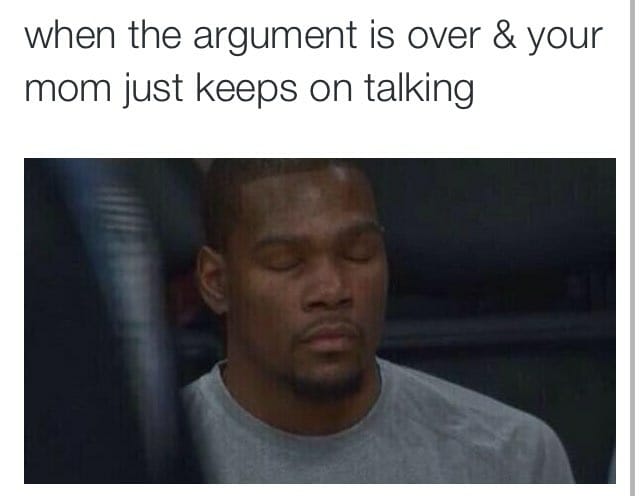
As a minority, witnessing someone claim that 2017 was the first time they felt ashamed of America pic.twitter.com/B802uT8kXu
— Matthew A. Cherry (@MatthewACherry)
As a minority, witnessing someone claim that 2017 was the first time they felt ashamed of America pic.twitter.com/B802uT8kXu
— Matthew A. Cherry (@MatthewACherry)
These memes, with their brief captions, are ideal for Twitter. Even if they originate elsewhere, they often feature the Twitter font in their text. Black Twitter excels at leveraging TFW and reaction GIFs, potentially pioneering the trend from the outset.
Memes centered around characters
Creating a fresh addition to the meme universe is incredibly challenging, but when it succeeds, the impact can surpass almost any other meme category. Harambe, the gorilla that died in 2016 following a child’s fall into his zoo habitat, evolved into a meme and was nearly deified by online communities. Pepe the Frog has grown into such a legendary figure that he’s become a twisted digital counterpart to Mickey Mouse—even influencing a U.S. presidential race. And let’s not overlook Dat Boi, the unicycle-riding frog. O shit, waddup?!

A meme character might take the form of an animated figure, such as Spongebob, Shrek, or the Minions. Alternatively, it could be a famous individual—Drake is a prime example—or even an ordinary person who unintentionally gained widespread attention. The latter scenario can often lead to significant complications.
During the early 2010s, online culture became obsessed with bystanders featured in local news segments, often exploiting these vibrant—frequently low-income, frequently Black—individuals by printing their images on T-shirts or incorporating them into AutoTuned song remixes. Fortunately, that uncomfortable period in meme culture has faded, though everyday people continue to be transformed into memes regularly. When this happens, the resulting spotlight rarely portrays them in a positive light.
Ken Bone, the mustachioed man in a sweater who posed a question during a 2016 presidential debate, was universally adored until his past offensive Reddit posts came to light. “Chewbacca Mom,” who filmed herself enjoying a moment of laughter in aStar WarsThe mask attempted to push her celebrity status beyond limits and encountered severe criticism. Outspoken feminists have been ridiculed as “Social Justice Warriors” and transformed into vicious internet jokes. For the majority, becoming a meme is far from an honor.
A phrase exists to describe the moment these short-lived heroes reveal their inevitable imperfections: They turn into a “milkshake duck.”
Despite the challenges, this year has seen some meme characters achieve real success. “Salt Bae,” the charismatic Turkish chef, leveraged his internet popularity to launch new restaurants. Similarly, Roadman Shaq, another character born from the creativity of Black British comedians, propelled their careers to unprecedented levels.
Text memes
Certain memes function without any visuals, relying solely on written content.
A text meme often consists of a catchphrase repeated word-for-word, keeping the humor alive by adapting it to fresh situations or trending topics. Take “Send nudes,” a semi-serious plea for explicit photos, which has been reused in countless scenarios after gaining popularity. Similarly, “Dicks out for Harambe” represents another instance of mindless content people eagerly replicated and shared in 2016.
In reality, a whole category of meme exists known as Copypasta, which describes lengthy, deliberately irritating chunks of text designed It might be a lengthy, menacing message from a self-proclaimed “Navy Seal,” or perhaps the complete script of Jerry Seinfeld’s stand-up routine.Bee Movie.The famous tweet referred to as “.” might be the one. Regardless, the comedy lies in its extended repetition.
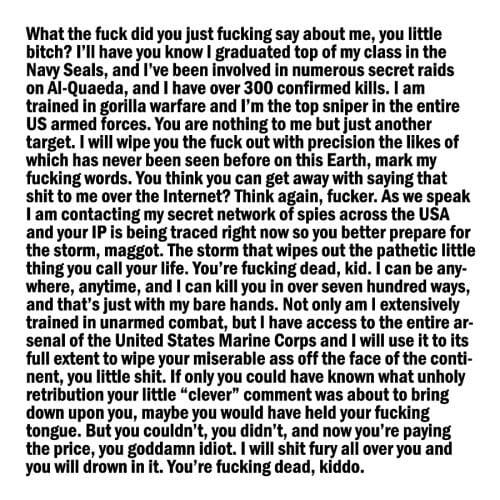
One of the most widespread types of text memes is the snowclone, a term in linguistics referring to reusable phrases that allow flexible word substitutions, such as “X is the new Y.”
Notable snowclones in meme culture feature Tumblr’s “Some People Use??? X to Cope???” and “I am forcibly removed from the premises,” along with “X machine broke” and “Me, an intellectual.” Tumblr remainsveryskilled with snowclones.
Ideas
One type of meme aligns so precisely with Dawkins’ initial, specific concept of a meme that it barely fits the modern online interpretation: the abstract idea or notion.
In this context, I’m talking about claims such as “Ted Cruz is the Zodiac Killer,” “universal healthcare enslaves physicians,” “Bernie was the true victor,” “the Babadook represents homosexuality,” or “millennials have a sense of entitlement.”
These don’t adhere to our meme principle of having a distinct structure that invites participation. While they spread rapidly like viruses, they lack the visual or linguistic playfulness characteristic of the other memes we’ve examined.
Certainly, depictions of the Babadook holding a rainbow flag, or word puzzles linking Cruz to the Zodiac, or bold proclamations like “Millennials are destroying X” provide shape to these memes, yet no standardized format exists for conveying such concepts.
To compare it to a more familiar format: Many poorly made television series revolve around the idea of “a clueless yet good-natured husband who has married a woman out of his league,” but not every TV showcalled“a dim-witted yet good-hearted husband has, against all odds, wed a woman beyond his social standing.”
Memes existaboutThe claim that Donald Trump collaborated with the Russian government has been widely discussed, though the accusation itself does not qualify as a meme.
One explanation for why the alt-right and Gamergate adopted Pepe the Frog as a symbol was to amplify their rhetoric about “cucks” and “cultural Marxism,” along with other white supremacist slogans. By leveraging a well-known, internet-born character, they infused their ideology—such as it was—with greater viral potential.
“Dank” and “Edgy” memes contrasted with “Normie” memes
In meme communities, the word “dank” is frequently used, such as in “r/dankmemes” or “Bernie’s Dank Meme Stash.” It serves as quick way to label a meme the uploader thinks is high-quality, though “dankness” also implies certain extra nuances.
Similar to how “dank weed” refers to highly potent marijuana, a dank meme is an exceptionally powerful meme. Whatever it embodies—whether irony, harshness, originality, or sharp cultural nods—it does so intensely. And just as with dank weed, those unfamiliar with the culture, who don’t regularly engage with memes, are unlikely to grasp the appeal of a dank meme.
These individuals—the majority—are “normies.” Normies scroll through Facebook and occasionally check Instagram. They share memes they find amusing via text, though usually long after the jokes have peaked. They prefer humor that feels familiar, not absurd or deliberately nonsensical “shitposting.” “lol, this is so me,” the normie remarks, sending an image macro to a friend or close pal.
Most ordinary people typically avoid sharing “edgy” memes—those that are transgressive, crude, or even offensive. Content centered on mental illness, suicide, school shootings, incest, sexual assault, or other sensitive subjects isn’t likely to gain widespread popularity on Facebook. In underground meme circles, “edginess” is frequently less about genuine expression and more about provoking reactions from fellow “shitlords” or deterring mainstream audiences from appropriating the meme.
While a meme’s structure and subject can be distinguished conceptually, they frequently remain intertwined in reality. Launching a new meme template by ridiculing children with autism ensures that, despite its potential for any humor, the meme will inevitably revolve around autism. It won’t appear on your mother’s Facebook feed, and you’ll definitely never encounter it on—Ellen.You might not be the best person, but that awful meme belongs to you forever. Savor it, if you want?
Dankness and edginess occasionally overlap, though they frequently don’t. Forced or humorless attempts to be provocative don’t qualify as dank, just as many dank memes lack any edginess.
Dankness isn’t the sole measure of a meme’s worth. Certain memes gain popularity through their relatability, thriving even without the obscure quality that typically defines cool memes.
The persistent dilemma for “meme economists” remains: should memes be judged for their trendy, rebellious appeal, or for their capacity to resonate with a wider audience? In practice, a meme functions much like any other commodity. While niche enthusiasts may initially propel its popularity, true staying power depends on reaching a mass audience.
Surreal and heavily distorted memes
Certain memes rely entirely on absurdity, unpredictability, and abstraction for their comedic effect, twisting a familiar, straightforward meme template until it becomes almost unrecognizable. These peculiar anomalies in meme culture typically divide into two groups: surreal memes and deep-fried memes.
Surreal memes, featured on platforms like and the Reddit community r/surrealmemes, twist conventional memes by incorporating nonsensical text and absurd scenarios. Visually, they frequently include pixelated “glitches,” distorted faces, and cosmic backdrops. Recurring elements like the “Meme Man” head or low-quality 3D models are also common. The irony of meme surrealism establishing its own recognizable aesthetic is undeniably humorous.

Deep-fried memes often spark debate. Similar to surreal memes, they alter established meme formats. However, the content they typically manipulate is “ghetto memes,” a specialized category built around racist caricatures of Black individuals.
A heavily edited image is processed through multiple Photoshop filters, resulting in a noisy, pixelated mess filled with JPEG artifacts. Characters frequently have unnaturally glowing eyes. For videos, deep-frying introduces automatic distortions, such as audio clipping from abrupt volume spikes. Common elements of deep-fried content include screenshots of iMessage chats, the term “thot,” and swapping numerous consonants with the “B” emoji.

The “B” emoji has become particularly controversial due to its widespread use as a substitute for white individuals to avoid explicitly typing the word “ni**a.” Initially, people would write “niBBa” using two “B” emojis. Over time, this trend expanded to replacing various letters with the “B” emoji, escalating to such an extent that Reddit’s r/dankmemes ultimately prohibited its use entirely.
A constructive application of deep-fried content emerged during the summer of 2017 with the “”” trend, featuring videos created by and centered around a Black teen. Phrases such as “boneless” and “can I get uhhh …?” gained widespread appeal across diverse audiences, partially restoring the artistic credibility of deep-fried memes.
What is the future of memes?
Memes, like any form of communication, carry risks: they can propagate conspiracy theories just as easily as humor. The 2016 election demonstrated that as memes grow in popularity, they also become increasingly politicized. Should they be dominated by alt-right agitators and provocative trolls, their broader cultural influence will stay constrained.
Comics are a versatile medium that can tell a wide range of stories, from battling villains to exploring deeper narratives. For years, they were dismissed as entertainment solely for white, male enthusiasts, but today, superhero films dominate popular culture, and independent comics are recognized as legitimate literary works.
Internet memes, by contrast, remain a relatively new phenomenon. The current battle for their “ownership” may shape the future trajectory of this medium for years ahead. Will Facebook’s older generation dominate? Or will it be the teenage users of Tumblr? Perhaps the Reddit enthusiasts obsessed with the “dank” meme culture? Alternatively, could it be the disillusioned youth on 4chan, fueled by racial and sexual hostility? Might corporations ultimately take control?
At times, memes become linked to specific groups or political movements. In 2017, for instance, the right has been especially active in dominating the meme landscape, leaving it uncertain whether the left will relinquish it. However, the reality is that memes are incredibly varied in style and subject matter, offering endless creative potential for everyone. They’re abundant and accessible to enjoy, and their creation and sharing require minimal effort.
Marshall McLuhan once argued that “the medium is the message,” and in the case of memes, the underlying implication is that everyone has the potential to be a creator, and any concept can gain traction on social media with the right presentation and promotion. However, since the distinction between consumer and creator is less defined than in traditional media, and because memes thrive on a sense of shared humor, disputes over “ownership” remain intense and unresolved.
The issue extends beyond intellectual property and financial gain—though that’s a compelling debate—it’s fundamentally about identity. Much like geeks and hipsters resist when their beloved franchises or bands gain mass appeal, holding onto their sense of being “true fans,” those shaping meme culture now must grapple with its expanding reach.
In five to ten years, claiming that “memes are only for teenage virgin white nationalists” will sound as ridiculous as saying “rock music is just for hippies” or “comics are only for nerds” does today.
Memes will evolve over time, and businesses might discover methods to monetize them, but they aren’t disappearing anytime soon. It’s best to adapt and accept their presence.
Dive deeper into Unclick



Newsletter: Revealing the truths McDonald’s keeps hidden from everyone

Black women are transforming TikTok’s princesscore trend with their innovative contributions.
Jay Hathaway
Jay Hathaway is an ex-senior writer known for covering internet memes and quirky digital culture. In the past, he held the role of news editor at the Daily Dot, worked as a staff writer for Gawker, and managed the iconic sites Urlesque and Download Squad. His writing has been featured on platforms like nymag.com, suicidegirls.com, and the Morning News.